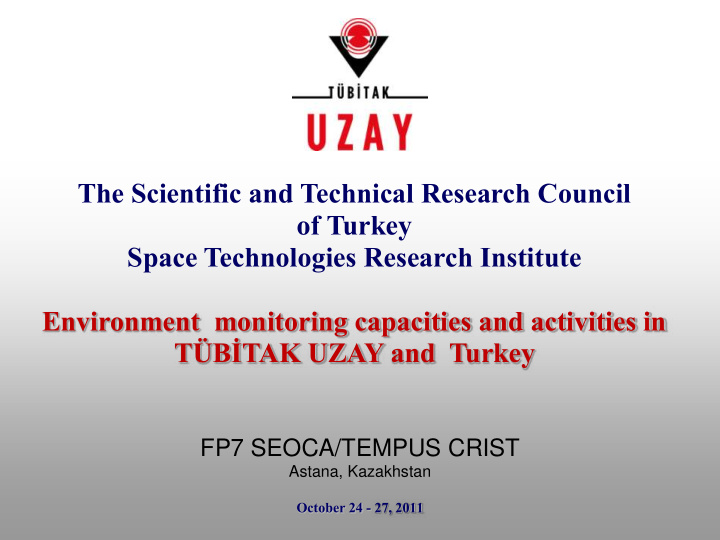



The Scientific and Technical Research Council of Turkey Space Technologies Research Institute Environment monitoring capacities and activities in TÜBİTAK UZAY and Turkey FP7 SEOCA/TEMPUS CRIST Astana, Kazakhstan October 24 - 27, 2011
Content • Short history of environmental monitoring • Capacities for enviromental analysis • First EO satellite of Turkey – RASAT Satellite sub systems • Needs & future studies for environmental monitoring
History of Environmental Monitoring in Turkey • Turkey has international obligations for environmental reporting mainly from UNEP, EU , OECD. • National Photogrammetry and Remote Sensing Union, (like ISPRS) has established in 1984. • National environment monitoring project launched at 1999, by Ministry of Environment.
Capacities for Enviromental Analysis • Several different National Institutes analyses environmental data – Ministries (Environment, Health, Agriculture..) – Statistic Institute, TÜBİTAK, – Mineral Research & Exploration General Directorate, since 1975 remote sensing unit, giving service with the analysis of Landsat images.
Researches for Ecological Monitoring • Determination of the water quality and urbanization analysis of the water basins and hydrodynamic structure and pollution of the Bosphorus by using satellite imagery data, (İTÜ and TÜBİTAK). • Forecasting Wheat Production Zones in Turkey (DPT/UBITEK). • Using GIS-based remotely sensed data dies to develop methods for characterization, classification and mapping of biotope type, a case study: Antalya-Manavgat region ( İTÜ and Environment and Forest Ministry Research Project).
Environmental Monitoring Today • Good knowhow level in academic studies for monitoring vegetation conditions, and ecological monitoring. • Expertise in using international satelite data (NOAA, Landsat, Spot Satellite, MODIS data) • Avaresness is raised in all level. • Increasing need of focused environmental data.
RASAT: First EO satellite of Turkey Dnepr launch vehicle operated by 2009 International Space Company Kosmotras (ISCK). Yasny Base of Russia at the 2010 Kazakh border 17 th August, 2011 2011
RASAT: First satellite designed and built in Turkey Objectives Technical Specifications Accumulate know-how to produce high LEO EO satellite with GSD of 7.5 m resolution satellites at low-risk Mass: ~95 kg Test higher technology products for Orbit: ~687 km, SSO upcoming satellites in space 3-axis contol Improve space based capabilities of Optical imaging system Turkish space industry 15 m MSI (red, blue, green, NIR) 7.5 m PAN UHF/ VHF/ S Band/X Band comms
RASAT Satellite Subsystems • Flight Computer with Spacewire • Flight Software • Ground Station Software, Mission Planning Software • Image Compression, Encryption and Processing Module • X-Band Transmitter
Capabilities – Communication Systems S Band Transmitter/Receiver & X Band Transmitter Communication system with 100 Mb/s downlink at 7W output. On Board RASAT!
Capabilities – On Board Image Processing On Board RASAT! GEZGiN-2: New generation image processor capable of high-speed multi-spectral image; compression using the JPEG2000 algorithms with encryption capabilities.
Capabilities – Flight Computer On Board RASAT! BiLGE: Flight computer with the capability to utilize Spacewire
Infrastructure Ground Station 5.5 m diameter S+X Band Antenna • UHF/VHF • S Band / X Band 3.7 m diameter S Band Antenna
Recent Photos from RASAT Beijing Airport, China, 16.10.2011 Adıyaman, Turkey, 11.10.2011
Recent Photos from RASAT Marsey, France, 12.10.2011 USA, Los Angeles, Harbour 12.10.2011
Need: Imaging Systems for Eco Monitoring • Monitoring of biodiversity, protection of natural resources require the most recent and correct information. • There are various ways of obtaining such information. – Field survey, traditional aerial photography – Challenges: insufficiency of the spectral capability of imagers to differentiate the features of interest or the impossibility of imaging at a very precise time or the insufficiency of ground sampling distance
Optical Imaging System Capability High resolution need for environmental monitoring: Thermo Electrically Cooled Satellite NIR Camera (KUZGUN)
Need: Imaging Systems for Eco Monitoring typical reflectance spectra Vegetation has a unique spectral signature that enables it to be distinguished readily from other types of land cover in an optical/near-infrared image . Source:http://spacegrant.nmsu.edu/statewide/projects/remote_sensing.pdf
Need: Imaging Systems for Eco Monitoring • A short-wave long infrared (SWIR, 800nm-1700nm) band can be used to precisely detect clouds and land areas. • Moisture is a key indicator of process control and quality in agriculture • Water is opaque to SWIR illumination, detecting its presence or absence can be useful in gauging crop health and product ripeness or dryness.
Need: Imaging Systems for Eco Monitoring • TÜBİTAK UZAY is developing high resolution monitoring capability for environmental and eco-system monitoring • KUZGUN will gain space heritage in 2012 • Future studies: – The development of hyper spectral imaging systems and <1m resolution satellite camera. – Specializing on environment applications of satellite data
www.uzay.tubitak.gov.tr rukiye.ozcivelek@uzay.tubitak.gov.tr
Recommend
More recommend